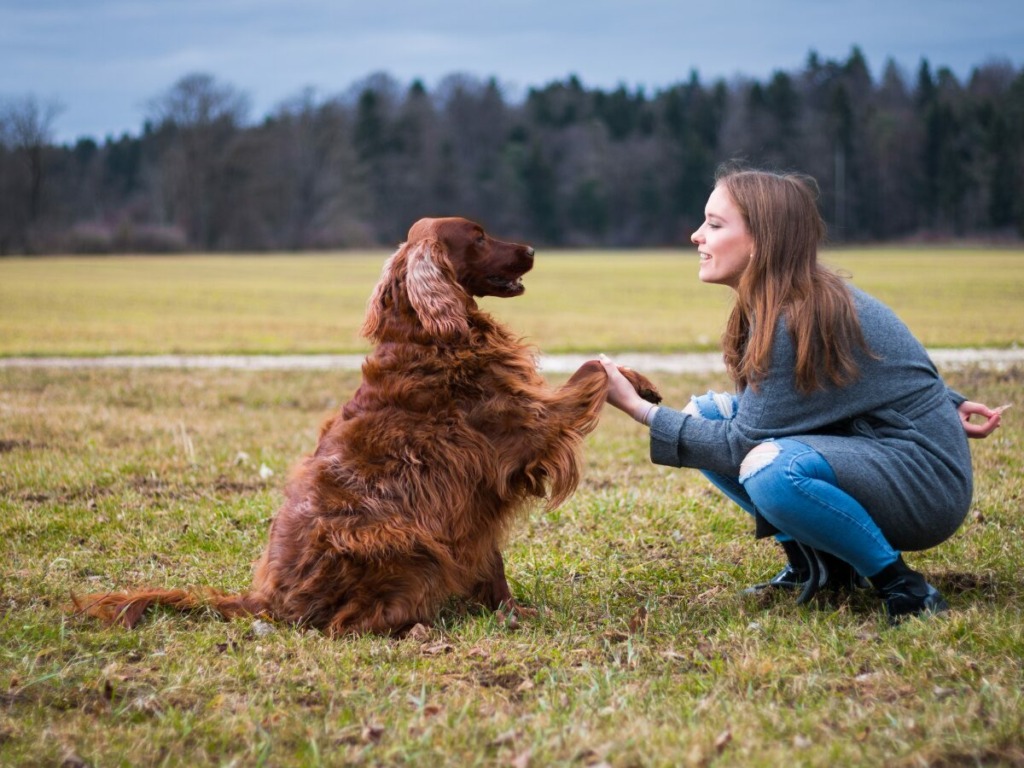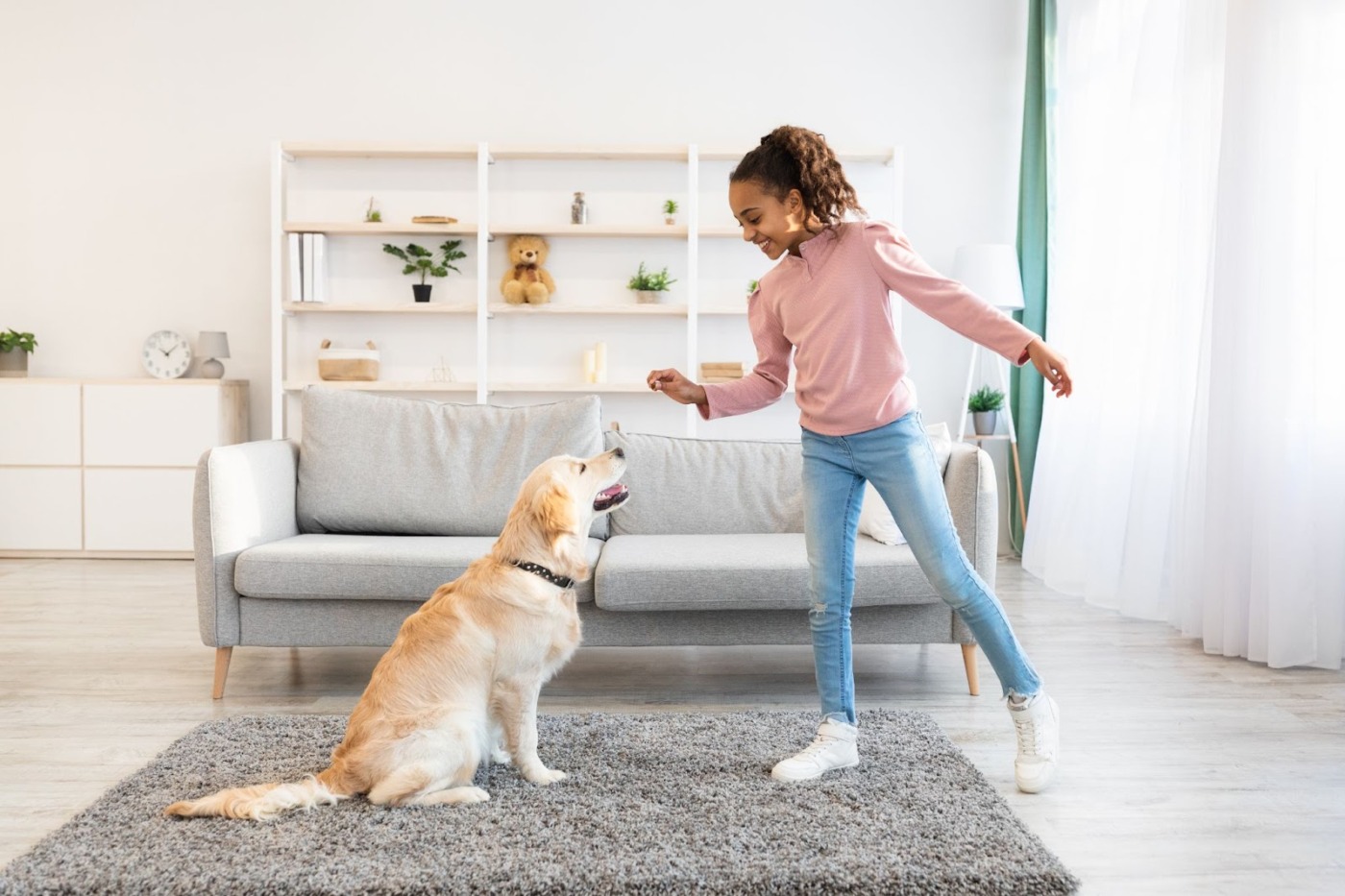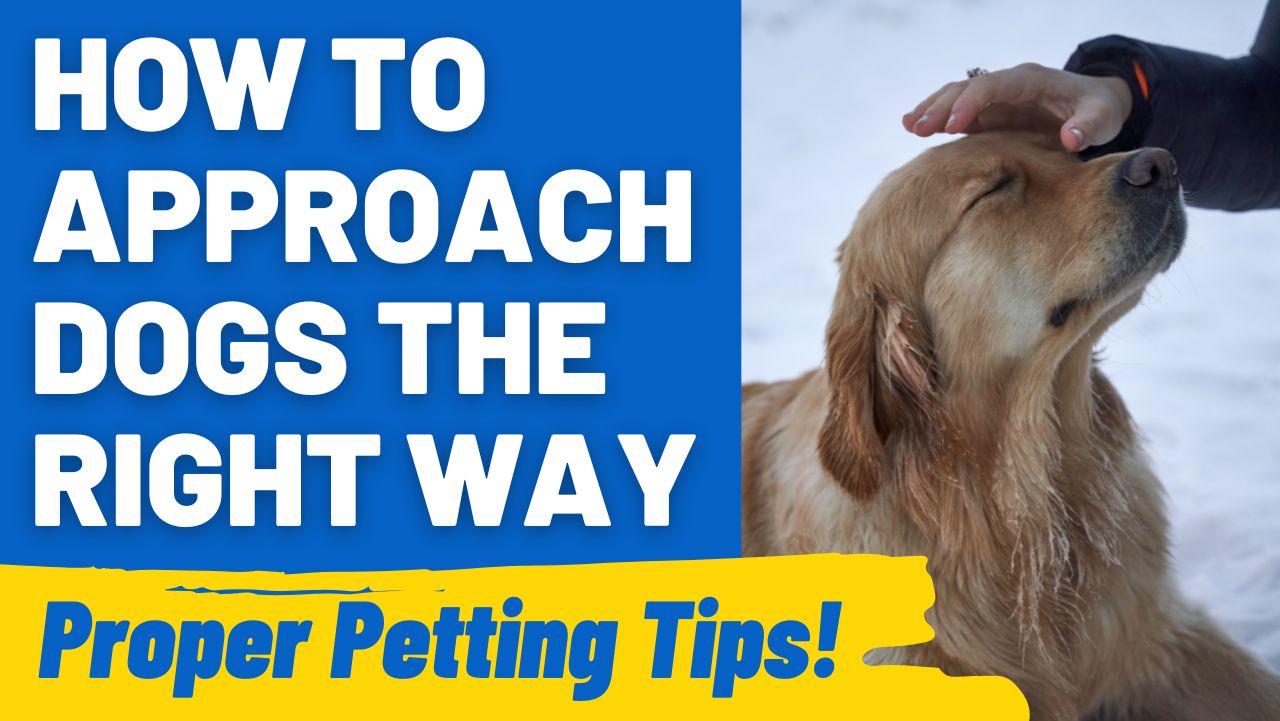“Can I pet that dog?” is often the first thought that pops into our minds when we see a furry friend wagging its tail.
The joy of petting a dog is unmatched, offering both the pet and the petter a sense of comfort and happiness. However, understanding a dog’s body language and knowing how to approach them is crucial to ensure a positive experience for both parties.
This article will dive into the art of petting dogs, highlighting the importance of respectful and safe interactions.
Join us as we explore how to make every petting moment a joyful one, keeping in mind the well-being of our canine companions.
What’s the Best Way to Approach a Dog?

Ever found yourself whispering, “Can I pet that dog?” as a fluffy tail catches your eye? Knowing the best way to approach a dog is key to a paw-sitive encounter.
Here’s a quick guide on approaching dogs safely, ensuring every interaction is a tail-wagging experience:
- Pause and Assess: Before you make a move, look at the dog’s body language. A relaxed posture and wagging tail are green lights, but if the dog seems tense or avoids eye contact, it’s best to refrain.
- Let Them Come to You: Instead of beelining towards the dog, squat or kneel down at a safe distance and let the dog approach you if it’s interested. This non-threatening stance respects the dog’s space and autonomy.
- Avoid Direct Eye Contact: Staring directly into a dog’s eyes can be perceived as a challenge. Glance sideways instead, keeping your demeanor calm and friendly.
- Offer a Hand: Extend your hand, palm down, and let the dog sniff it. This canine handshake is a polite way to say hello.
Can You Pet Service Dogs?
Service dogs are a special case. While the urge to pet them can be strong, remember that these dogs are working. Disturbing them can distract them from their important tasks.
Generally, the rule of thumb is simple: don’t pet service dogs without the handler’s permission. Respect their space and role.
Speaking of service dogs, you should read our post about Can Any Dog Be Trained as a Service Dog? Understanding the Criteria
Interacting with Unknown Dogs
Encountering an unknown dog, perhaps a stray or a new furry neighbor, brings up the question, “Can I pet that dog?”
Here’s how to navigate such encounters with care:
- Observe First: Watch the dog’s behavior from a distance. If the dog seems relaxed and curious, you might have a chance for a friendly interaction.
- Proceed with Caution: Approach slowly and let the dog notice you. Avoid sudden movements that might startle the dog.
- Speak Softly: Use a gentle, soothing voice to convey your friendly intentions.
When it comes to petting stray dogs safely or interacting with unknown dogs, it’s always better to err on the side of caution. Not every dog is comfortable with human interaction, and respecting their space is paramount.
How Can You Tell If a Dog Wants to Be Petted?
Recognizing whether a dog is inviting you to pet it requires understanding canine body language, including being aware of the signs of dog aggression. Reading dog body language is key to interpreting these signals accurately.
Here’s how you can discern a dog’s willingness to be petted:
- Tail Wagging: A gently wagging tail suggests a happy dog, but a stiff wag can mean the opposite.
- Relaxed Body: A relaxed stance, possibly with a slight lean towards you, indicates a willingness to be petted.
- Soft Eyes and Face: Look for a relaxed facial expression with soft eyes. A hard stare might mean the dog needs space.
- Ear Position: Comfortable, naturally positioned ears are a good sign. Pinned back ears suggest discomfort.
Dogs’ Petting Preferences
Understanding dogs’ comfort zones is essential for a rewarding interaction. Most dogs enjoy gentle strokes on their chest, shoulders, or the base of the neck.
For dogs that are a bit shy or need time to warm up, incorporating a simple activity like offering treats from a treat dispensing toy, like Hide’n’Treat, can make them feel more at ease. This approach helps build trust, making the dog more receptive to petting.
Paying attention to a dog’s reaction to your touch will guide you on their preferred petting spots and when they’ve had enough.
Are There Specific Techniques for Petting Dogs?
When you’re thinking about petting a dog, knowing a few dog-friendly greeting methods can make all the difference.
Here’s how to tailor your approach:
- Gentle Approach: Start with a calm and gentle approach, especially with smaller or more timid dogs. This shows you’re friendly, not a threat.
- Open Palm: Offer an open palm for the dog to sniff before petting. This dog behavior understanding step lets them get to know you first.
- Soft Strokes: Use soft, slow strokes rather than vigorous pats, particularly with breeds that might be more sensitive or nervous.
- Read the Room: Pay attention to the dog’s reaction. If they lean in, they’re probably enjoying it. If they pull away, it’s time to stop.
Each dog is an individual with its likes and dislikes, influenced by size, breed, and temperament. For instance, a large, fluffy breed might enjoy a good back scratch, while a small, short-haired dog might prefer gentle strokes on the side.
Always observe and adapt to the dog’s responses, ensuring your petting session is enjoyable for both of you.
What Are the Safety Considerations When Petting Dogs?

When the thought “Can I pet that dog?” crosses your mind, considering safety is just as important as the excitement of making a new furry friend.
Let’s dive into petting dogs and hygiene, ensuring every pat is a safe one:
Hygiene is paramount. Always wash your hands before and after petting dogs to prevent the spread of germs.
Dogs explore the world with their noses and mouths, which means they can carry various bacteria and viruses on their fur and skin.
Be mindful of a dog’s comfort zone. Start with a gentle approach, avoiding sensitive areas like the face, ears, and tail until you’re sure the dog is comfortable with you.
Watch for signs of discomfort or stress in the dog, such as pulling away, growling, or a stiff body posture. These signs mean it’s time to stop.
Respect the dog’s personal space. Don’t force interaction if the dog seems uninterested or scared.
Table: Safe Petting Techniques and Considerations
| Technique | Areas to Avoid | Hygiene Tips |
| Gentle Strokes | Face, Ears, Tail | Wash hands before/after petting |
| Open Palm for Sniffing | Sensitive Body Parts | Use hand sanitizer if water is unavailable |
| Let the Dog Approach | Paws unless permitted | Avoid petting if you have open wounds |
| Observe Dog’s Reaction | Immediate Surroundings | Ensure the dog is comfortable |
Following these guidelines ensures a joyful and safe interaction for both you and the dog, making petting a dog a positive experience filled with wagging tails and happy hearts.
How Should Children Be Taught to Pet Dogs?

Teaching children how to interact with dogs involves more than just the mechanics of petting. It encompasses imparting canine approaching techniques and teaching dog approaching etiquette, ensuring safe and positive experiences for both kids and dogs.
Here’s how to blend these concepts effectively:
- Begin with Basics: Start by teaching kids the fundamental canine approaching techniques. This includes showing them how to calmly approach a dog, and to always ask for permission – both from the dog’s owner and the dog itself, by observing its body language.
- Role-Play Scenarios: Use role-playing to demonstrate dog approaching etiquette. Have children practice approaching an imaginary dog, using gentle movements and soft voices.
- Model Respectful Behavior: Children learn by example. Show them how to gently offer a hand for the dog to sniff and where to pet a dog, emphasizing the need to avoid sensitive areas like the face and tail.
- Emphasize Consent and Comfort: Teach children the importance of a dog’s consent for being petted. Explain that if a dog seems uninterested or moves away, they should respect the dog’s space.
By combining the teaching of canine approaching techniques with dog approaching etiquette, children can develop a respectful and understanding approach towards interacting with dogs, which is crucial for the safety and comfort of both parties.
Conclusion: Building a Bond Through Respectful Petting
Respecting a dog’s space and comfort is the cornerstone of a strong bond between humans and dogs. Following the guidelines for petting dogs isn’t just about manners. It’s about fostering trust and friendship.
Every gentle pat, and every careful approach, speaks volumes to our furry friends, telling them we care and respect their feelings. So, the next time you’re moved to ask, “Can I pet that dog?” remember these principles.
Practice respectful petting, and watch as the bond with your four-legged companions grows deeper and more meaningful.
Ready to Strengthen Your Bond?
Craving more tail wags and happy licks from your furry friend? Dive deeper into the world of engaging and enriching playtime with your pup at HoundGames.
Discover toys that do more than just entertain; they’re designed to enhance your dog’s life and strengthen the bond between you.
From expert insights to innovative playthings, HoundGames is your go-to for fostering a joyful, healthy relationship with your dog. Don’t just play—connect.
Visit us now and make every moment with your pup unforgettable.




